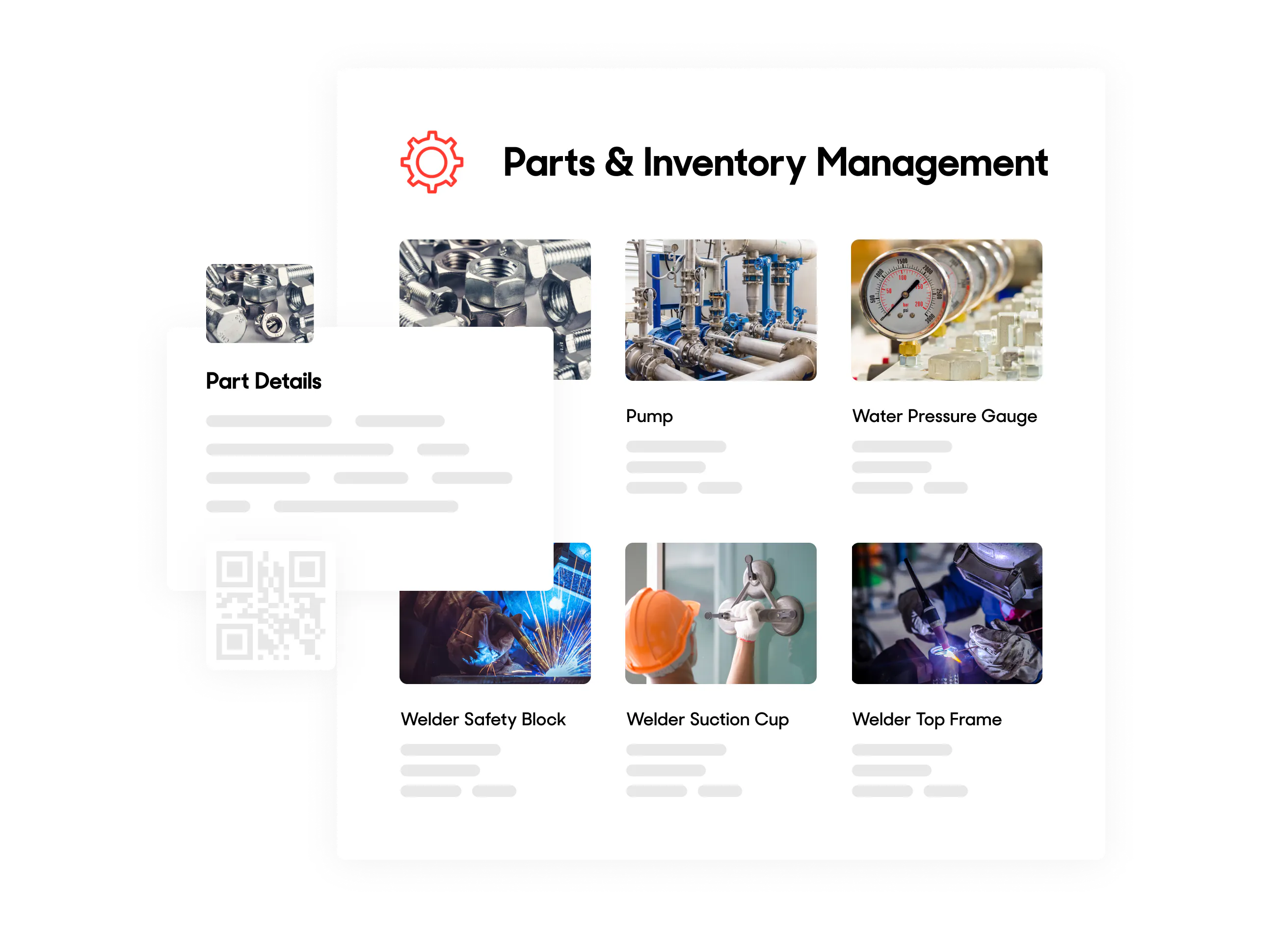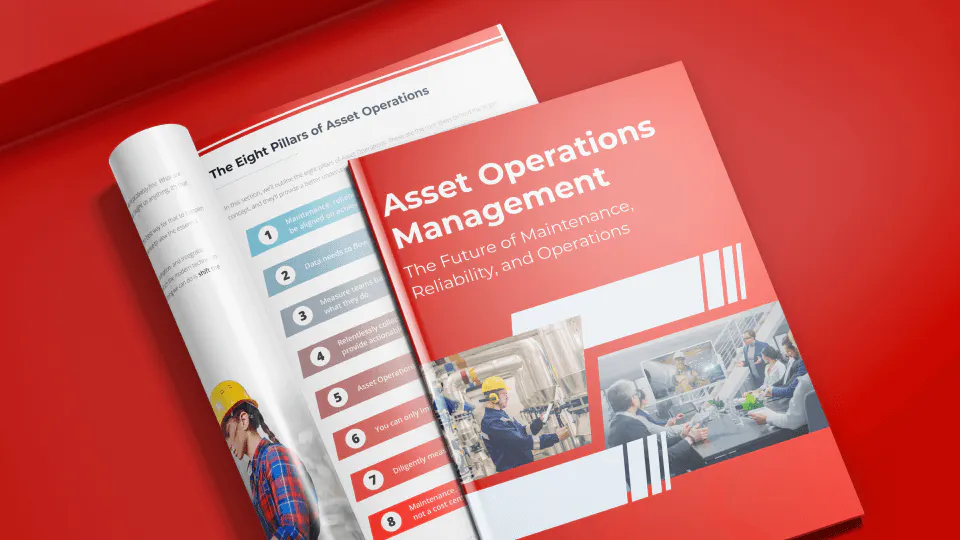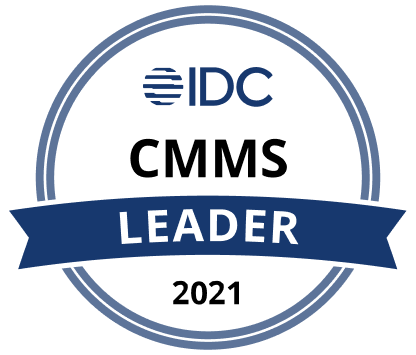What is Inventory Management?
Within facilities management, inventory management tracks items from the moment of purchase through its time of use. The best inventory management systems include complete and detailed records of materials and items so that they can be tracked and used efficiently.
Inventory of any nature is simply an investment that incurs ongoing costs such as storage space, management, and insurance. Best practices focus on having the right level of inventory to avoid downtime yet a minimal amount of inventory to manage, store, and insure.

Interesting Stats and Facts About Inventory Management
Here are some of the most interesting statistics and facts about inventory management, from its everyday impact to obscure numbers that most people never realize.
Money and Finances
Inventory, accounts receivable, and accounts payable amount to $1.1 trillion in assets. That’s about 7% of the US GDP.
Warehouse space in the United States costs about $5.08 per square foot.
American retailers carry about $1.43 in inventory for every $1 of sales.
A top reason startups fall is that they do not manage their inventory.
The Inner Workings of Inventory Management
75% of all supply chain management professionals want to improve their inventory management practices.
48% of supply chain management and transportation executives state that they need to reevaluate their warehouse locations.
24% of small businesses track their inventory with a pen and paper.
As a result of these and other statistics, many retailers and manufacturers are investing in better inventory management solutions.
Inventory Management and Maintenance Statistics
67% of warehouses plan to use mobile devices to speed up their inventory management.
Warehouse management solutions are a must today. 25% more retailers are investing in new systems.
The top issue in 46% of warehouses today is human error.
7% of small businesses don’t track inventory at all!
It’s clear that inventory management can be costly if it’s not conducted appropriately. On the other hand, effective inventory management methods can reduce costs dramatically.
Common Methods of Inventory Management
Most facilities will use either a just-in-time inventory method or a materials requirement planning system.
Just-in-Time Inventory Management
Those companies who use the first method try to minimize or even eliminate inventory levels by receiving items only when they are needed. Ideally, the just-in-time method eliminates storage costs, resources tied up in unused inventory, and overall waste. In the real world, however, it can be difficult to manage just-in-time inventory when demand for items may be unpredictable and supply throughout the larger supply chain may be unreliable.
Materials Requirement Planning System
The materials requirement planning method involves anticipating the materials, items, and supplies a facility may need in a given period and purchasing accordingly. This system requires excellent record keeping as well as reliable tracking of inventory materials so they can be located, used, and recorded accurately.
Let's take a look at how inventory control can be an effective practice to build into your inventory management processes.
Inventory control
Inventory control, also known as stock control, refers to the process of managing a company’s warehouse inventory levels. The inventory control process involves managing items from the moment they are ordered; throughout their storage, movement, and usage; to their final destination or disposal. Many systems, processes, and technologies have been developed over the years to help companies streamline supply chain processes.
Note: According to Investopedia, inventory is usually one of the largest “current assets” appearing on a business’ balance sheet. As a result, finding ways to manage inventory efficiently can significantly impact an organization’s bottom line.
Important Inventory Control Processes and Formulas
Over time, different control processes and formulas were created in order to help companies with the complexity that is inventory control. Let’s take a look at what some of these are and why they are important for companies today.
Quality Control
Quality control is an essential part of inventory control, and the processes you use have a dramatic impact. When you work with a supplier that has the same quality standards as you do, over time, you develop a long term relationship. Once you have your suppliers, batch tracking ensures your stock consistently meets your highest quality standards.
Organizational Control
It may seem like a simple concept, but it does make a difference to have your stock meticulously organized. This begins by labeling your stock with SKUs that are easily understandable and simple to read. Start with an initial stocktake and then use the right inventory management techniques to keep track of movements and levels.
Reorder Point Formula
The Reorder point determines the right time to order more stock. Calculating this means adding together your lead time demand in days and safety stock in days.
Basically, reorder point = lead time demand + safety stock.
Economic Order Quantity (EOQ)
Finally, EOQ is the optimum inventory you should purchase to minimize the costs of ordering and holding. You’ll need to know your annual fixed costs, demand in units, and carrying costs per unit (H) in order to calculate this.
Then, you can use the formula summed up by Accounting Coach: the square root of [(two times the annual demand in units times the incremental cost to process an order) divided by (the incremental annual cost to carry one unit in inventory)] in order to find your economic order quantity.
Managing Inventory with an Inventory Control System
An inventory control system is a computerized solution that brings all aspects of inventory management into one cohesive system. Its purpose is to help control your stock in order to hold the least amount of inventory in your warehouses and ultimately improve cash flow and lower holding costs.
A wide range of manufacturing, distribution, and retail facilities use inventory control to manage the movement of items throughout their business. Some businesses may be tracking the movement of finished products from suppliers to customers while others many need to order raw materials to produce a finished product. Facilities managers may need to track maintenance, repair, and operations (MRO) inventory, which includes items like hand tools and janitorial supplies used to keep an organization running.
In all cases, items must be identified with a name or number, barcode, or radio frequency identification (RFID) tag so that they can be easily tracked. Items are then manually recorded or automatically scanned so that they can be followed and managed in a central computer system such as a CMMS.
Integration into a main computerized system as well as high quality data are key to a successful inventory management system.
An effective inventory control system can help you ensure that you have the right amount of raw materials, MRO supplies, or finished items on hand to meet your demand. This may mean higher customer satisfaction or reduced downtime on a manufacturing line.
Understanding what you have in inventory and where it is located can eliminate write-offs and unnecessary re-ordering to replace lost items. If you have an integrated system, you can authorize automatic re-orders on critical items and manage suppliers and invoicing more efficiently as well.
What Does an Inventory Management System Do?
An inventory management system keeps track of items that an organization purchases to manufacture or deliver its final product or service to its customers. It usually includes an array of hardware, software, and processes to identify and follow an item from the moment it enters a facility to the moment it is either used in a final product or consumed.
You probably think about inventory items as those things that are used by a company to create its product. For example, an air conditioner manufacturer might carry inventory items such as condensers, fans, belts, coils, and refrigerant.
Although those raw materials are tracked in an inventory management system, companies should also be following maintenance, repair, and operations (MRO) inventory. According to Supply Chain Mangement Review, roughly 40 percent of a company’s purchasing budget may be spent on MRO items such as janitorial supplies and maintenance tools.
Components Required in an Inventory Management System
A good inventory management system should contain certain components including an identification system, management software, and standardized procedures.
Identification System
An identification system can be a manual recording of model or parts numbers in a spreadsheet, a bar coding system that tags each item, or a complex radio frequency identification system that involves microchip tags.
Management Software
A centralized computer system like a CMMS can be used to record, track, and report the information on an ongoing basis. An integrated inventory tagging system and a CMMS can provide insights into real-time inventory data and subsequently help with making better purchasing decisions.
Standardized Procedures
Finally, a company should have clear, consistent processes in place in terms of tagging, documentation, and reporting requirements so that high quality data is generated. All team members should receive regular training on these processes.
Benefits of an Inventory Management System
An accurate inventory management system can improve an organization’s efficiency and productivity. When items for both production and MRO activities are ordered as close to just-in-time as possible, a facility reduces the space, management, and costs associated with carrying excess inventory.
In addition, a lean inventory can improve cash flow, forecasting reports, organization, and supplier relationships.
Let’s explore these benefits in a little more detail.
1. Increased Efficiency
Every item you keep in your inventory costs money month after month. By keeping your inventory as lean as possible, you reduce your overhead by eliminating purchases that may not be immediately necessary and minimizing item obsolescence. You’re better able to quickly identify needed items, acquire those items in a timely manner, and move them through your system with minimal delays and hiccups.
2. Improved Cash Flow
A healthy inventory management system means healthy processes, whether you’re keeping a production line up and running or moving finished units out for sale through retailers. You’re better able to fulfill orders, assess usage patterns, and minimize costs. Poor inventory management, on the other hand, can create delays when it comes to maintaining critical equipment, often resulting in hundreds of thousands of dollars in lost production.
3. Better Forecasting
When you’re on top of inventory management, you’re better able to anticipate what items you need to order to keep everything running smoothly. That necessitates a solid inventory forecasting process, and that process in turn helps other areas such as financial reporting, just-in-time ordering, and minimized stock-outs.
4. Increased Organization
Inventory management improves organization. When handled well, you always know exactly where everything is, how much of it you have in stock, and what it’s all used for. For instance, an MRO inventory tracked through a CMMS would be limited to only those items linked to your assets along with free stock and general supplies. The benefit here comes out to minimized waste in terms of time and purchasing decisions.
5. Improved Supplier Relationships
Effective inventory management incentivizes more consistent communication with your suppliers. You might make arrangements for recurring orders for frequently needed parts or negotiate better prices with suppliers you prefer to work with. In some cases, you may need to switch to suppliers who more reliably meet your facility’s needs, potentially creating a better (and more profitable) working relationship.
What Are the Different Types of Inventory Systems?
Facilities typically use one of three kinds of inventory systems: manual, periodic, and perpetual. Although technological requirements and the complexity of implementation increase as you move from the first to the last, efficiency and accuracy are improved as well.
Manual Inventory System
In the past, all facilities needed to track inventory manually by counting items in stock. Today, some small businesses that carry low levels of inventory may still use a manual system. An employee essentially goes through the inventory, counts all items, writes down results, and enters the quantities in a spreadsheet. This information can then be used to re-order materials as needed.
Periodic Inventory System
Periodic inventory systems have become the bridge between manual systems and perpetual systems. Inventory can be tracked manually and periodically; however, barcoding systems have improved periodic inventory systems a great deal.
Facilities can easily implement a barcode system by tagging inventory items. These barcodes are periodically scanned to track the item from its arrival to the facility, throughout its travel or usage within the facility, and its final destination when it is either used in a finished product or consumed.
A central computerized tracking system can then provide routine access to the quantities and locations of items as well as initiate re-stocking orders.
Perpetual Inventory System
The most sophisticated inventory system delivers real-time data. As soon as inventory enters a facility, is moved, sold, used, or thrown out, the central system is immediately updated.
Radio frequency identification (RFID) tags play a large role in perpetual inventory systems. Active RFID tags can constantly send data and provide real-time information while passive RFID tags use electromagnetic energy from a reader to transmit data. Data from RFID tags can be sent to a CMMS system, giving management transparency into inventory levels that can help them make smarter business decisions.
Best Types of Inventory Systems for Your Facility
Of course, these are just basic overviews of the different types of inventory systems you might implement in your facility. It’s important to know when to implement each type, what their strengths are, and how they can best support your operations. More details can be found here.
How to Choose an Inventory Management System
Inventory management is often best handled through software solutions, though manual systems may still be optimal for small scale applications. When choosing an inventory management system, you’ll need to take into account your organization’s goals, the challenges you currently face, and your existing infrastructure.
Determine Your Goals and Requirements
Organizational objectives are key when choosing any software solution, and that remains true for inventory management systems. In addition to high level objectives, you’ll also need to consider the challenges your facility faces. Knowing those challenges will inform the features you search for when choosing a system.
Outline Your Inventory Management Policies
Your current inventory management policies should also inform your choice of system. Your management policies can give you insight into how you go about moving inventory through your facility, and you’ll gain insight into matters such as handling requirements and lead times. This information can then help you decide which solution is best for your organization.
Look for Features to Support Your Requirements
Once you know your existing processes, current challenges, and operational needs, you’ll be in a position to look for features that satisfy your requirements. When it comes to choosing a software solution, some of the features you might look for include:
· Inventory tracking
· Barcoding
· Real-time analytics
· Scalability
· Reporting features (charts, reports, dashboards)
Remember to keep ease of use in mind as well. The usability of a software solution will affect the investment you’ll need to make in terms of training.
Consider Implementation
Finally, there’s the matter of implementation. Some inventory management systems may require little more than installing new features into an existing piece of software (such as adding features to a CMMS for MRO inventory management), while others may require a more involved integration process. The decision between mobile, server-based, and cloud-based solutions will also come into play here.
Flexibility is also worth considering here as well. If you anticipate high levels of growth in coming years, you’ll want a system that is highly scalable with plenty of support from the provider.
Common Inventory Management Techniques
Inventory management can develop into a complex process that incorporates numerous techniques and strategies, especially in larger applications with various moving parts. Some of the most common techniques found in modern inventory management processes include those described here.
ABC Analysis
ABC analysis is a process of prioritizing inventory items for the purposes of determining how much control and recordkeeping each item needs. Stock is divided into A, B, and C categories, with A items having the most control / recordkeeping and C having the least.
Batch Tracking
With batch tracking, you group similar items together. For instance, items with the same expiration date or that came in the same shipment might be batched together, creating support for additional techniques such as FIFO (first in, first out) or LIFO (last in, first out).
Cycle Counting
Rather than counting all inventory items at once, many storerooms use cycle counting, in which only a handful of items are counted each day. Over the course of a year, the entire inventory would be counted with only a minimal investment of time each day.
Demand Forecasting
Predictive analytics can be used to determine what demand will be on items in the future. For instance, demand forecasting for MRO inventory can predict how many of a given part will be used in coming months, making it possible to recommend purchases before that part is needed.
First In, First Out (FIFO)
A “first in, first out” (FIFO) policy is the practice of using stock items in the order in which you receive them. This is best for items that deteriorate over time or in contexts where items move through your storeroom/warehouse quickly.
Last In, Last Out (LIFO)
LIFO is the opposite of FIFO in that the last items that come in are the first ones out. This is best for items that do not deteriorate over time, and it can minimize the costs of inventory that increases in cost the longer you hold on to it.
Minimum Order Quantity
Generally, you don’t want to order more of a given item than you actually need. Minimum order quantity is a figure of the lowest number of a given stock item you need to order from suppliers, which can help minimize carrying costs.
Safety Stock
Some extra items might be kept as safety stock in the event that it becomes impossible to replenish them in a timely manner. Safety stock may be used as a safeguard against production line failures that involve hard-to-replace components, supply chain delays, or other scenarios that might prevent a company from obtaining certain items.
Six Sigma
Six Sigma is a method used to make sure a process consistently has quality output. Lean Six Sigma adds lean methodologies to eliminate numerous kinds of waste. When implemented in inventory management, Lean Six Sigma can help support continuous improvement.
Inventory Management Challenges
Owing to the range of both external and internal factors that impact inventory management, there are various challenges that facilities may face. The following challenges may impede effective management, but they can all be addressed with the right preparation as well.
Poor Communication
One challenge is poor communication. When data isn’t freely shared between departments, it can make inventory management techniques such as forecasting and planning difficult. Information should be shared within and between departments, whether that means sharing data on existing trends or making reports on spare parts used in repairs.
Insufficient Accountability
In connection with poor communication is insufficient accountability. Many MRO inventory problems stem from team members failing to record which parts they use in repairs. Often, this comes from a lack of any kind of safeguard or established process for checking out parts, and that means there is less accountability when it comes to using up stock items.
Lack of Visible Data
Data must be shared freely within your organization and carefully recorded. It should also be collected from processes that impact (and are impacted by) your inventory management. When it is collected, it should be usable, and that means giving stakeholders sufficient access. If data isn’t visible, it can negatively impact decision making and diminish the cost effectiveness of your processes.
Fluctuations in Supply and Demand
The availability and shipping times of supplies, the demand for products, and the needs of production assets are all in a state of constant flux. That can make forecasting, reordering, and other inventory management processes a challenge, particularly in facilities with a wide range of moving elements. Predictive analytics coupled with inventory data can counteract this, as can the use of other techniques.
Skill Gaps
Trades, manufacturing, and other industries are facing a skills gap when it comes to hiring qualified personnel. That gap can have a significant impact on inventory management. Certain inventory management practices may require training that current staff simply doesn’t have, especially when it comes to implementing advanced processes an procedures.
Inefficient Processes
Finally, inventory storerooms and warehouses are often the scene of inefficient processes. For instance, a small facility may be fine using manual inventory management, but as it grows, that system quickly becomes inefficient. Obstacles may also exist at various points in the process, making it harder to collect and act upon data, carry out plans, etc.
The Costs of Poorly Optimized Inventory Management
Businesses spend an average of 25% to 35% of their budget on inventory costs. This means that poorly optimized inventory management can get quite expensive.
Typically, high inventory management costs come from buying either too many or too few items.
In this article, we discuss four costs of poorly optimized inventory management:
Higher carrying costs
Increased carrying costs from spare parts inventory, insurance, and taxes
Losses from overbuying
Missing items and stockouts
Higher Carrying Costs
If a facility manager often overspends and poorly manages inventory, then they might face extra carrying costs. Carrying costs are defined as how much it costs to keep inventory on hand, and they may come in the form of storage space, insurance, operational costs, salaries, and even taxes.
Carrying costs account for about 25% of a given company’s total inventory costs.
That percentage can climb to 40% in some cases.
Increased Carrying Costs from Spare Parts Inventory, Insurance, and Taxes
MRO inventory frequently includes spare parts. While it’s good to have extra parts on hand, those can increase inventory carrying costs. As such, it’s important to streamline your spare parts inventory.
MRO inventory typically turns over less than once per year.
That extra inventory lying around results in recurring costs, including about 5% of its total value in insurance costs.
Some states include taxes on existing business inventory. For instance, the state of Mississippi brought in about $168 million from inventory taxes back in 2010.
Losses from Overbuying
Overbuying on inventory leads to losses, both in terms of carrying costs as well as markdowns. In order to eliminate excess inventory, markdowns are frequently necessary for retailers.
On average, non-grocery retailers only sell about 60% of their stock at full price.
Markdowns account for about $300 billion in lost revenue in the United States.
Roughly half of all retailers cite inventory misjudgments as the cause of these losses.
Missing Items and Stockouts
Poor MRO inventory management leads to increased downtime costs in that parts either run out or simply become difficult to find.
Unplanned downtime could cost up to $260,000 per hour.
Delays resulting from an item being out of stock could also lead to lost customers.
How Can I Optimize My Inventory Management?
In one of the studies referenced here, about 86% of retailers knew specific ways in which advanced analytics could help them cut inventory management costs.
Ultimately, it all comes down to knowing exactly how much of each item you need, how much of it you currently have, and how quickly you can find it. IoT solutions and inventory management software can both help you keep on top of those items.
Examples of Inventory Management
To better understand what inventory management might look like in your facility, let’s look at some hypothetical examples.
1. Manufacturing Facility – Raw Materials Inventory Management
A company that manufactures action figures keeps a healthy stock of PVC plastic pellets. Every several weeks, they run low on material, slowing down production until more PVC can be ordered. The cost of getting material to the facility in a timely manner is high, as is the regular lull in production.
To combat this problem, the company assembles a team to assess their resupply practices. They use a reorder point formula to determine when they need to reorder stock based on their production needs. After implementing some procedures in their storeroom to make sure orders occur on time, they’re able to solve their productivity issue without having to expand their storeroom’s square footage.
2. Streamlining MRO Inventory Management
The same facility has regular stockouts on some of the replacement parts for their casting machines. After analyzing work order histories in their CMMS and comparing those to their inventory management software, it is discovered that one of their technicians isn’t checking out the parts when carrying out preventive maintenance work orders on the machines.
The team performs a quick count on the parts, updates their inventory counts in their system, and mounts a lock on the storeroom door along with a surveillance camera. Technicians no longer have access to parts without talking to the storeroom manager, who enforces the policy of checking out parts with a work order.
3. Using Vendor Managed Inventory to Reduce Costs
Other replacement parts in this facility take up a lot of space in the storeroom, and they’re fairly sensitive to their environment to boot, reducing their shelf life. The storeroom management team decides that it would be worthwhile to have the vendor hold onto these parts until they’re actually needed (which occurs at fairly regular time intervals).
They talk with the vendor and set up a VMI (vendor managed inventory) agreement with them. At a regular interval based on the mean time between failures (MTBF) of the part, their vendor sends them the part, saving them the cost of storing it.
How to Measure Inventory Performance
Inventory performance can be measured through both qualitative (descriptive) and quantitative (numerical) KPIs. Some quantitative metrics include inventory turnover, stockouts, inactive stock, carrying costs, and order cycle time. Measuring inventory performance is key to effective MRO storeroom management.
What Is Inventory Accounting?
Inventory accounting is the segment of accounting that tracks the value of current inventory items, as well as the changes that occur when new items arrive or raw materials are consumed. If your business manages inventory, you need to account for all of the moving pieces across the company’s computerized system. Part of keeping track of your inventory is knowing what you have and how much it is worth at any given point in time.
Let’s take a look at the principles of inventory accounting and the different systems that companies and businesses use today.
Inventory Accounting Basics
Because inventory is a business asset, company accountants must use a logical and consistent method to assign a value to the inventory. This directly impacts the expense of the cost of goods and the amount of income received.
Most product-based businesses must pick a system and stick with it in order to keep their inventory accounting manageable. However, the first system chosen is often not the best choice as the company grows and evolves. That’s when knowing what your options are before you make the choice comes into play.
Different System Options
The most basic inventory accounting methods are first-in-first-out and last-in-first-out, commonly known as FIFO and LIFO, respectively. They are the most established systems and are fairly self-explanatory. While these are good, solid systems, the fact is that your inventory and restocking systems may not be as simple as that.
Instead, the weighted average method and specific identification methods may be better choices. Weighted average methods continually adjust the weighted average cost as new product comes in and out. This might be better for companies that deal with higher fluctuations in product costs. Specific identification methods track each item separately from start to finish and may be better for businesses that deal with high-value products.
All of these inventory accounting systems are viable options, but your needs will dictate which is your best option.
Tip: Keep in mind that while a system may not make much sense in the earlier phases of your business, it’s worth taking a second look at the principles of inventory accounting and your alternative options before deciding on a system for the long run.
Improve your inventory management system with a CMMS
According to industry studies, more than $100 billion is spent on operating and maintenance materials by facilities each year. These studies also estimate that about 10 percent of this inventory never gets used. This may be caused by over-purchasing to obtain a volume discount, repeat buying when already owned materials cannot be located, or errors due to poor inventory records management.
Choosing the right inventory management software will have a tremendous impact on your inventory control processes. And it can be either good or bad. Good software streamlines the process; lower quality software creates an additional set of issues that companies then need to deal with on top of everything else
By employing CMMS and fostering an employee culture focused on gathering and recording accurate data, facilities can better track inventory levels, manage purchasing decisions, and gain insight into areas where improvements can be made. These inventory management improvements can make a significant impact on a facility’s bottom line. Systems, such as UpKeep’s inventory management software, with an integrated inventory tracking app, can enable you to get insight into your inventory in the time it takes to walk into the storeroom and out.
When you use a set of processes and formulas in tandem with the right inventory management software, inventory control and inventory management can be simple. It’s up to the companies to build the right framework to support it.

On-Demand Webinar
The Future of Maintenance: Asset Operations Management
Uniquely positioned to tackle industry challenges, UpKeep brings maintenance, reliability, and operations teams together in a new approach called Asset Operations Management.

On-Demand Webinar
Asset Operations Management for Healthcare
Join UpKeep CEO and Founder, Ryan Chan, to gain a deeper understanding of what the healthcare industry is facing—from regulatory oversight to managing an increasing number of connected devices.

Whitepaper
Asset Operations Management: The Future of Maintenance, Reliability, and Operations
4,000+ COMPANIES RELY ON ASSET OPERATIONS MANAGEMENT
Leading the Way to a Better Future for Maintenance and Reliability


